Anti-aircraft missile and artillery system HQ-11 (China)
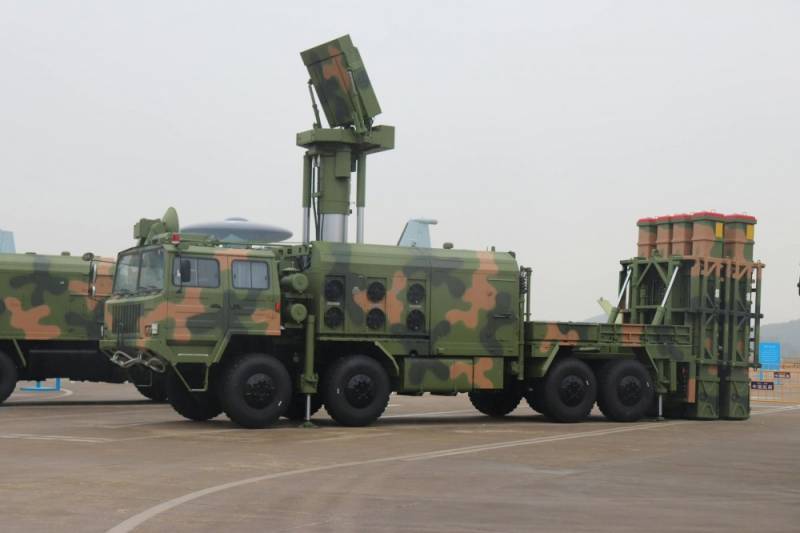
Missile unit ZRAK HJ-11
The Chinese defense industry continues to develop the direction of short-range anti-aircraft missile and artillery systems for object air defense. The latest known development in this class is the ZRAK HQ-11, first introduced a few months ago. This project was based on proven solutions and a number of ready-made components, and due to the latter, it was possible to obtain an increase in firing characteristics.
Premiere in Moscow
The promising missile and artillery system HQ-11 (Hong Qi-11 - "Red Banner-11") was developed in the recent past by the China Aerospace Science and Industry Corporation (CASIC). The finished ZRAK was first officially shown to the public and specialists in November last year at the Airshow China 2022 exhibition. It is curious that the exhibit was designated H-11 on the information plate, and this violated the logic of naming Chinese air defense systems / ZRAK.
The exhibition demonstrated two components of the new complex - an anti-aircraft missile launcher and an artillery system on the same four-axle chassis. Both machines were on the exhibition floor in a combat position. They were hung out with hydraulic jacks; radar systems were raised to the working position, and the missile launcher was lowered to the ground.
Unfortunately, the first showing of the ZRAK HQ-11 did not go into much detail. The full composition of the complex, performance characteristics, etc. did not call. However, some features of the appearance made it possible to speculate and draw the first conclusions.
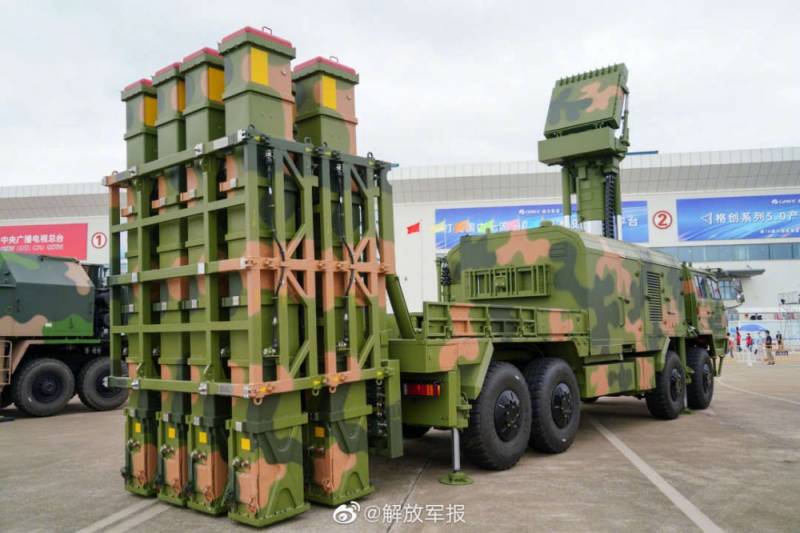
Also, the current status of the project and its prospects were not reported at Airshow China 2022. Perhaps the development of the HQ-11 has progressed far enough that it allowed the finished products to be shown at a public event. The launch of the series and the supply of products to the PLA or for export has not yet been reported. However, China almost never shares such information, and the start of production or operation usually becomes known with a significant delay.
New Component
As it turned out, not all the facilities of the complex were shown at last year's exhibition. In early March, photos of the vehicle appeared on Chinese social media, which unambiguously identified another HQ-11 component that had not previously been shown at public events. An unknown sample was filmed near Shanghai on a public highway.
The machine is made on a four-axle special chassis and is generally similar to the previously shown self-propelled launcher. At the same time, the set of special equipment is different and indicates a different role. So, on the cargo platform of the machine there is an additional cab of reduced length, and behind it is a crane. In the aft part of the chassis there is a rack or a swinging installation for eight transport and launch containers with missiles.
The appearance and architecture, as well as the characteristic shape of the TPK missiles, suggest that the seen machine is directly related to the new ZRAK HQ-11. Apparently, this is a transport-loading vehicle designed to ensure the combat operation of the missile part of the complex. If the TPK package is made swinging, then it can be a launcher-loader with a transport and combat function.
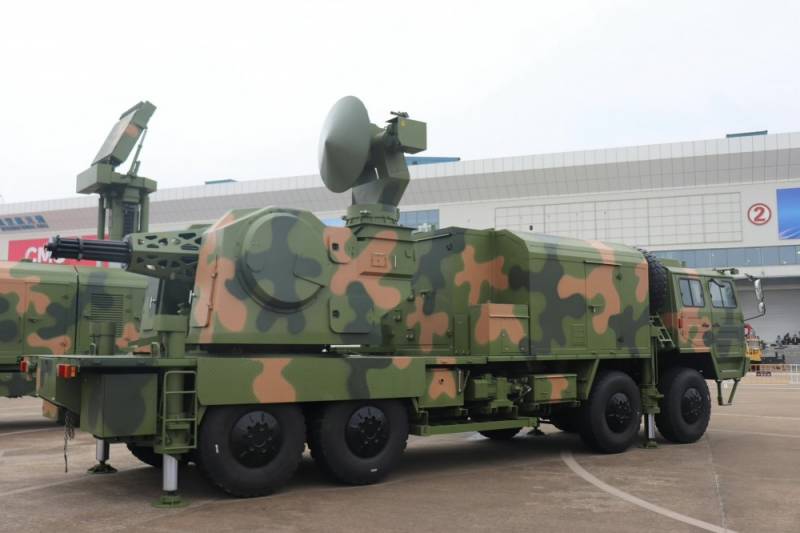
Artillery system LD-3000
anti-aircraft weapons
Reportedly, the HQ-11 is a short-range anti-aircraft missile and artillery system designed for long-term duty in position and combat a wide range of targets. It should detect and hit aircraft and helicopters, UAVs of various classes, high-precision weapon etc. The complex includes a launcher, missiles, an artillery system and a transport-loading or launch-loading vehicle. Possibly, the ZRAK may include other means, such as a separate radar or command post.
The mobile launcher from the HQ-11 is actually an independent combat unit. An operator's cabin with controls, a target detection radar with phased array, and a launcher for eight missiles are mounted on one chassis.
The type of anti-aircraft missile used in the HQ-11 complex has not yet been reported. The performance characteristics are also unknown. ZRAK is positioned as a short-range system, which limits the missile's flight to 25-30 km.
The missiles are complemented by the LD-3000 artillery system. It is also made on a chassis and has its own operator's cabin. It uses a modified H / PJ-11 naval combat module as a fire weapon. This is a remote-controlled turret with an 11-barreled 30 mm cannon. It has its own target tracking and guidance radar; an optical-electronic station is interlocked with it.
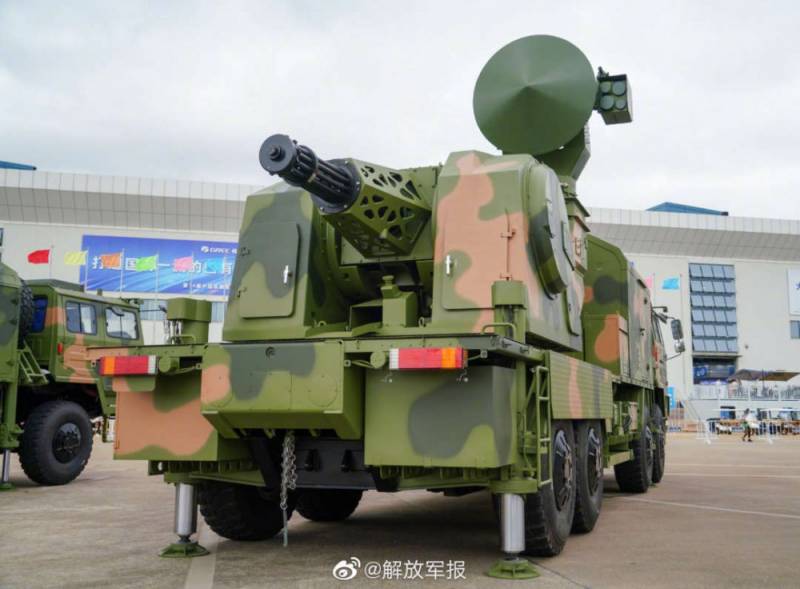
The radar and OLS of the H / PJ-11 module provides detection and tracking of air targets at ranges of at least 15-20 km, depending on various factors. The rate of fire of the gun is in the range of 9-11 thousand shots / min. The maximum effective range of fire reaches 5 km. The effective range for surface targets is 2,5-3 km, for missiles or similar objects - up to 1-1,5 km. Due to the layout of the combat vehicle, the tower does not have a circular pickup.
The HQ-11 complex is able to move along highways or off-road and change position. However, some preparation is required to get started. The means of the complex are placed in position, leveled and interfaced with each other by radio. Apparently, ZRAK can act as an independent combat unit and autonomously solve the tasks of detecting and hitting targets. It should also have network capabilities - work on external target designation or issue data on the air situation to other complexes.
Features and Benefits
In terms of overall architecture, features and capabilities, the new Chinese ZRAK HQ-11 is similar to older systems such as the HQ-6. Due to this, characteristic advantages are preserved in the form of mobility, the possibility of changing the composition of the complex, etc. At the same time, new components are used along with proven ideas, which provides additional benefits.
ZRAK HQ-11 includes two types of weapons with fundamentally different capabilities and different characteristics. This makes it a more flexible system, and also allows one complex to organize defense with two echelons. The main part of the targets should be intercepted by missiles at a greater distance, and the rest will be hit by a gun in the near zone.
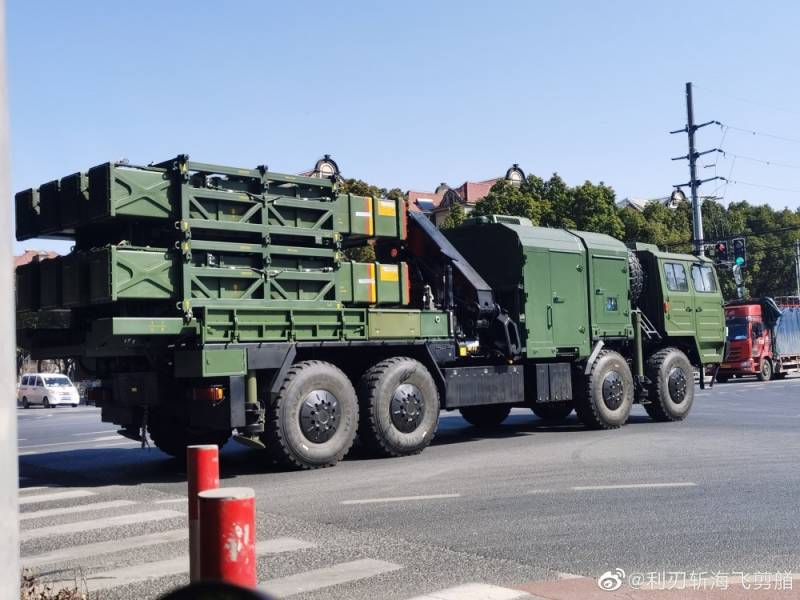
Transport-loading or launch-loading machine of the complex
The new complex, apparently, uses its own missiles. According to the main characteristics, it can surpass the existing products of its class and give the complex as a whole additional advantages.
The HQ-11 uses the LD-3000 artillery mount with a 30mm gun. The latter is distinguished by the highest rate of fire and the corresponding fighting qualities. With all the restrictions, such weapons should provide a high probability of hitting targets, incl. complex.
The HQ-11 must be highly flexible in use. Each of its means is actually an autonomous combat vehicle and is capable of solving tasks on its own. Their combined use as part of the complex provides additional advantages. At the same time, the composition of the ZRAK is probably not constant and can be determined taking into account the requirements of the customer.
Development continues
The HQ-11 anti-aircraft missile and artillery system, presented last year, shows that the Chinese industry continues to deal with air defense and is working on all major areas in this area. At the same time, using the example of such a ZRAK, one can see that CASIC and other organizations are not only developing new equipment from scratch, but also actively using available components.
However, the exact prospects for the new Chinese ZRAK are still unknown. The HJ-11 has already reached the stage where it can be shown to the public, but it is not yet clear what will happen next. It is possible that the development organization is already preparing production, and soon the HJ-11 will enter service with the PLA or some foreign country.
Information